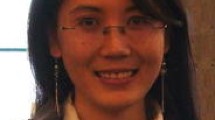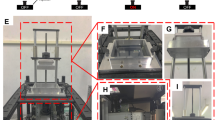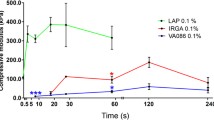Abstract
Tissue engineered scaffolds are needed to support physiological loads and emulate the micrometer-scale strain gradients within tissues that guide cell mechanobiological responses. We designed and fabricated micro-truss structures to possess spatially varying geometry and controlled stiffness gradients. Using a custom projection microstereolithography (μSLA) system, using digital light projection (DLP), and photopolymerizable poly(ethylene glycol) diacrylate (PEGDA) hydrogel monomers, three designs with feature sizes < 200 μm were formed: (1) uniform structure with 1 MPa structural modulus (\(E\)) designed to match equilibrium modulus of healthy articular cartilage, (2) \(E\) = 1 MPa gradient structure designed to vary strain with depth, and (3) osteochondral bilayer with distinct cartilage (\(E\) = 1 MPa) and bone (\(E\) = 7 MPa) layers. Finite element models (FEM) guided design and predicted the local mechanical environment. Empty trusses and poly(ethylene glycol) norbornene hydrogel-infilled composite trusses were compressed during X-ray microscopy (XRM) imaging to evaluate regional stiffnesses. Our designs achieved target moduli for cartilage and bone while maintaining 68–81% porosity. Combined XRM imaging and compression of empty and hydrogel-infilled micro-truss structures revealed regional stiffnesses that were accurately predicted by FEM. In the infilling hydrogel, FEM demonstrated the stress-shielding effect of reinforcing structures while predicting strain distributions. Composite scaffolds made from stiff μSLA-printed polymers support physiological load levels and enable controlled mechanical property gradients which may improve in vivo outcomes for osteochondral defect tissue regeneration. Advanced 3D imaging and FE analysis provide insights into the local mechanical environment surrounding cells in composite scaffolds.








Similar content being viewed by others
References
Abaci, A., and M. Guvendiren. Designing decellularized extracellular matrix-based bioinks for 3D bioprinting. Adv. Healthc. Mater. 9:2000734, 2020. https://doi.org/10.1002/adhm.202000734.
Aisenbrey, E. A., and S. J. Bryant. Mechanical loading inhibits hypertrophy in chondrogenically differentiating hMSCs within a biomimetic hydrogel. J. Mater. Chem. B 4:3562–3574, 2016. https://doi.org/10.1039/c6tb00006a.
Aisenbrey, E. A., and S. J. Bryant. A MMP7-sensitive photoclickable biomimetic hydrogel for MSC encapsulation towards engineering human cartilage. J. Biomed. Mater. Res. A 106A:2344–2355, 2018. https://doi.org/10.1002/jbm.a.36412.
Aisenbrey, E. A., A. Tomaschke, E. Kleinjan, A. Muralidharan, C. Pascual-Garrido, R. R. McLeod, V. L. Ferguson, and S. J. Bryant. A stereolithography-based 3D printed hybrid scaffold for in situ cartilage defect repair. Macromol. Biosci. 2018. https://doi.org/10.1002/mabi.201700267.
Aisenbrey, E. A., A. A. Tomaschke, S. A. Schoonraad, K. M. Fischenich, J. A. Wahlquist, M. A. Randolph, V. L. Ferguson, and S. J. Bryant. Assessment and prevention of cartilage degeneration surrounding a focal chondral defect in the porcine model. Biochem. Biophys. Res. Commun. 514:940–945, 2019. https://doi.org/10.1016/j.bbrc.2019.05.034.
Allen, K. D., L. M. Thoma, and Y. M. Golightly. Epidemiology of osteoarthritis. Osteoarthr. Cartil. 30:184–195, 2022. https://doi.org/10.1016/j.joca.2021.04.020.
Arcaute, K., B. K. Mann, and R. B. Wicker. Stereolithography of three-dimensional bioactive poly(ethylene glycol) constructs with encapsulated cells. Ann. Biomed. Eng. 34:1429–1441, 2006. https://doi.org/10.1007/s10439-006-9156-y.
Aziz, A. H., K. Eckstein, V. L. Ferguson, and S. J. Bryant. The effects of dynamic compressive loading on human mesenchymal stem cell osteogenesis in the stiff layer of a bilayer hydrogel. J. Tissue Eng. Regener. Med. 13:946–959, 2019. https://doi.org/10.1002/term.2827.
Bartell, L. R., L. A. Fortier, L. J. Bonassar, and I. Cohen. Measuring microscale strain fields in articular cartilage during rapid impact reveals thresholds for chondrocyte death and a protective role for the superficial layer. J. Biomech. 48:3440–3446, 2015. https://doi.org/10.1016/j.jbiomech.2015.05.035.
Beck, E. C., M. Barragan, M. H. Tadros, S. H. Gehrke, and M. S. Detamore. Approaching the compressive modulus of articular cartilage with a decellularized cartilage-based hydrogel. Acta Biomater. 38:94–105, 2016. https://doi.org/10.1016/j.actbio.2016.04.019.
Bennett, J. Measuring UV curing parameters of commercial photopolymers used in additive manufacturing. Addit. Manuf. 18:203–212, 2017. https://doi.org/10.1016/j.addma.2017.10.009.
Bittner, S. M., B. T. Smith, L. Diaz-Gomez, C. D. Hudgins, A. J. Melchiorri, D. W. Scott, J. P. Fisher, and A. G. Mikos. Fabrication and mechanical characterization of 3D printed vertical uniform and gradient scaffolds for bone and osteochondral tissue engineering. Acta Biomater. 90:37–48, 2019. https://doi.org/10.1016/j.actbio.2019.03.041.
Bobyn, J. D., R. M. Pilliar, H. U. Cameron, and G. C. Weatherly. The optimum pore size for the fixation of porous-surfaced metal implants by the ingrowth of bone. Clin. Orthop. Relat. Res. 150:263–270, 1980.
Bracaglia, L. G., B. T. Smith, E. Watson, N. Arumugasaamy, A. G. Mikos, and J. P. Fisher. 3D printing for the design and fabrication of polymer-based gradient scaffolds. Acta Biomater. 56:3–13, 2017. https://doi.org/10.1016/j.actbio.2017.03.030.
Bryant, S. J., and K. S. Anseth. Hydrogel properties influence ECM production by chondrocytes photoencapsulated in poly(ethylene glycol) hydrogels. J. Biomed. Mater. Res. 59:63–72, 2002. https://doi.org/10.1002/jbm.1217.
Burdis, R., F. Chariyev-Prinz, and D. J. Kelly. Bioprinting of biomimetic self-organised cartilage with a supporting joint fixation device. Biofabrication 2021. https://doi.org/10.1088/1758-5090/ac36be.
Carter, D. R., G. S. Beaupré, M. Wong, R. L. Smith, T. P. Andriacchi, and D. J. Schurman. The mechanobiology of articular cartilage development and degeneration. Clin. Orthop. Relat. Res.® 427:S69, 2004. https://doi.org/10.1097/01.blo.0000144970.05107.7e.
Chu, T. C., W. F. Ranson, and M. A. Sutton. Applications of digital-image-correlation techniques to experimental mechanics. Exp. Mech. 25:232–244, 1985. https://doi.org/10.1007/BF02325092.
Critchley, S., E. J. Sheehy, G. Cunniffe, P. Diaz-Payno, S. F. Carroll, O. Jeon, E. Alsberg, P. A. J. Brama, and D. J. Kelly. 3D printing of fibre-reinforced cartilaginous templates for the regeneration of osteochondral defects. Acta Biomater. 113:130–143, 2020. https://doi.org/10.1016/j.actbio.2020.05.040.
Daly, A. C., F. E. Freeman, T. Gonzalez-Fernandez, S. E. Critchley, J. Nulty, and D. J. Kelly. 3D bioprinting for cartilage and osteochondral tissue engineering. Adv. Healthc. Mater. 2017. https://doi.org/10.1002/adhm.201700298.
Daly, A. C., and D. J. Kelly. Biofabrication of spatially organised tissues by directing the growth of cellular spheroids within 3D printed polymeric microchambers. Biomaterials 197:194–206, 2019. https://doi.org/10.1016/j.biomaterials.2018.12.028.
Deshpande, V. S., N. A. Fleck, and M. F. Ashby. Effective properties of the octet-truss lattice material. J. Mech. Phys. Solids 49:1747–1769, 2001. https://doi.org/10.1016/S0022-5096(01)00010-2.
Diaz-Rodriguez, P., J. D. Erndt-Marino, T. Gharat, D. J. Munoz Pinto, S. Samavedi, R. Bearden, M. A. Grunlan, W. B. Saunders, and M. S. Hahn. Toward zonally tailored scaffolds for osteochondral differentiation of synovial mesenchymal stem cells. J. Biomed. Mater. Res. B 107:2019–2029, 2019. https://doi.org/10.1002/jbm.b.34293.
Ding, M., C. C. Danielsen, and I. Hvid. Bone density does not reflect mechanical properties in early-stage arthrosis. Acta Orthop. Scand. 72:181–185, 2001. https://doi.org/10.1080/000164701317323444.
Doyle, S. E., F. Snow, S. Duchi, C. D. O’Connell, C. Onofrillo, C. Di Bella, and E. Pirogova. 3D printed multiphasic scaffolds for osteochondral repair: challenges and opportunities. Int. J. Mol. Sci. 22:12420, 2021. https://doi.org/10.3390/ijms222212420.
Eckstein, K. N. Micro-truss models for 3D printed scaffold reinforcements. OSF. 2024. https://osf.io/J93DB/. https://doi.org/10.17605/OSF.IO/J93DB.
Ege, D., and V. Hasirci. Is 3D printing promising for osteochondral tissue regeneration? ACS Appl. Bio Mater. 6:1431–1444, 2023. https://doi.org/10.1021/acsabm.3c00093.
Erickson, A. E., J. Sun, S. K. Lan Levengood, S. Swanson, F.-C. Chang, C. T. Tsao, and M. Zhang. Chitosan-based composite bilayer scaffold as an in vitro osteochondral defect regeneration model. Biomed. Microdevices 21:34, 2019. https://doi.org/10.1007/s10544-019-0373-1.
Golebiowska, A. A., and S. P. Nukavarapu. Bio-inspired zonal-structured matrices for bone-cartilage interface engineering. Biofabrication 14:025016, 2022. https://doi.org/10.1088/1758-5090/ac5413.
Griffin, D. J., E. D. Bonnevie, D. J. Lachowsky, J. C. A. Hart, H. D. Sparks, N. Moran, G. Matthews, A. J. Nixon, I. Cohen, and L. J. Bonassar. Mechanical characterization of matrix-induced autologous chondrocyte implantation (MACI®) grafts in an equine model at 53 weeks. J. Biomech. 48:1944–1949, 2015. https://doi.org/10.1016/j.jbiomech.2015.04.010.
Guilak, F., A. Ratcliffe, and V. C. Mow. Chondrocyte deformation and local tissue strain in articular cartilage: a confocal microscopy study. J. Orthop. Res. 13:410–421, 1995. https://doi.org/10.1002/jor.1100130315.
Guo, T., J. Lembong, L. G. Zhang, and J. P. Fisher. Three-dimensional printing articular cartilage: recapitulating the complexity of native tissue. Tissue Eng. B 23:225–236, 2017. https://doi.org/10.1089/ten.TEB.2016.0316.
Hanke, M. S., M. J. B. Keel, J. L. Cullmann, K. A. Siebenrock, and J. D. Bastian. Transfer of osteochondral shell autografts to salvage femoral head impaction injuries in hip trauma patients. Injury 51:711–718, 2020. https://doi.org/10.1016/j.injury.2020.01.037.
Huey, D. J., J. C. Hu, and K. A. Athanasiou. Unlike bone, cartilage regeneration remains elusive. Science 338:917–921, 2012. https://doi.org/10.1126/science.1222454.
Itälä, A. I., H. O. Ylänen, C. Ekholm, K. H. Karlsson, and H. T. Aro. Pore diameter of more than 100 μm is not requisite for bone ingrowth in rabbits. J. Biomed. Mater. Res. 58:679–683, 2001. https://doi.org/10.1002/jbm.1069.
Johannes, K. G., K. N. Calahan, Y. Qi, R. Long, and M. E. Rentschler. Three-dimensional microscale imaging and measurement of soft material contact interfaces under quasi-static normal indentation and shear. Langmuir 35:10725–10733, 2019. https://doi.org/10.1021/acs.langmuir.9b00830.
Jurvelin, J. S., M. D. Buschmann, and E. B. Hunziker. Optical and mechanical determination of Poisson’s ratio of adult bovine humeral articular cartilage. J. Biomech. 30:235–241, 1997. https://doi.org/10.1016/s0021-9290(96)00133-9.
Kaur, M., T. G. Yun, S. M. Han, E. L. Thomas, and W. S. Kim. 3D printed stretching-dominated micro-trusses. Mater. Des. 134:272–280, 2017. https://doi.org/10.1016/j.matdes.2017.08.061.
Kilian, D., T. Ahlfeld, A. R. Akkineni, A. Bernhardt, M. Gelinsky, and A. Lode. 3D bioprinting of osteochondral tissue substitutes—in vitro-chondrogenesis in multi-layered mineralized constructs. Sci. Rep. 10:8277, 2020. https://doi.org/10.1038/s41598-020-65050-9.
Kinneberg, K. R. C., A. Nelson, M. E. Stender, A. H. Aziz, L. C. Mozdzen, B. A. C. Harley, S. J. Bryant, and V. L. Ferguson. Reinforcement of mono- and bi-layer poly(ethylene glycol) hydrogels with a fibrous collagen scaffold. Ann. Biomed. Eng. 43:2618–2629, 2015. https://doi.org/10.1007/s10439-015-1337-0.
Li, C., W. Zhang, Y. Nie, D. Jiang, J. Jia, W. Zhang, L. Li, Z. Yao, L. Qin, and Y. Lai. Integrated and bifunctional bilayer 3D printing scaffold for osteochondral defect repair. Adv. Funct. Mater. 33:2214158, 2023. https://doi.org/10.1002/adfm.202214158.
Little, C. J., N. K. Bawolin, and X. Chen. Mechanical properties of natural cartilage and tissue-engineered constructs. Tissue Eng. B 17:213–227, 2011. https://doi.org/10.1089/ten.TEB.2010.0572.
Middendorf, J. M., D. J. Griffin, S. Shortkroff, C. Dugopolski, S. Kennedy, J. Siemiatkoski, I. Cohen, and L. J. Bonassar. Mechanical properties and structure-function relationships of human chondrocyte-seeded cartilage constructs after in vitro culture. J. Orthop. Res. 35:2298–2306, 2017. https://doi.org/10.1002/jor.23535.
Moutos, F. T., and F. Guilak. Composite scaffolds for cartilage tissue engineering. Biorheology 45:501–512, 2008.
Muralidharan, A., R. R. McLeod, and S. J. Bryant. Hydrolytically degradable poly(β-amino ester) resins with tunable degradation for 3D printing by projection micro-stereolithography. Adv. Funct. Mater. 32:2106509, 2022. https://doi.org/10.1002/adfm.202106509.
Murphy, L., and C. G. Helmick. The impact of osteoarthritis in the United States: a population-health perspective: a population-based review of the fourth most common cause of hospitalization in U.S. adults. Orthop. Nurs. 31:85–91, 2012. https://doi.org/10.1097/NOR.0b013e31824fcd42.
Nicodemus, G. D., and S. J. Bryant. The role of hydrogel structure and dynamic loading on chondrocyte gene expression and matrix formation. J. Biomech. 41:1528–1536, 2008. https://doi.org/10.1016/j.jbiomech.2008.02.034.
Niemeyer, P., J. M. Pestka, P. C. Kreuz, C. Erggelet, H. Schmal, N. P. Suedkamp, and M. Steinwachs. Characteristic complications after autologous chondrocyte implantation for cartilage defects of the knee joint. Am. J. Sports Med. 36:2091–2099, 2008. https://doi.org/10.1177/0363546508322131.
Prendergast, P. J., R. Huiskes, and K. Søballe. Biophysical stimuli on cells during tissue differentiation at implant interfaces. J. Biomech. 30:539–548, 1997. https://doi.org/10.1016/S0021-9290(96)00140-6.
Rackson, C. M., K. M. Champley, J. T. Toombs, E. J. Fong, V. Bansal, H. K. Taylor, M. Shusteff, and R. R. McLeod. Object-space optimization of tomographic reconstructions for additive manufacturing. Addit. Manuf. 48:102367, 2021. https://doi.org/10.1016/j.addma.2021.102367.
Schinagl, R. M., D. Gurskis, A. C. Chen, and R. L. Sah. Depth-dependent confined compression modulus of full-thickness bovine articular cartilage. J. Orthop. Res. 15:499–506, 1997. https://doi.org/10.1002/jor.1100150404.
Schipani, R., S. Scheurer, R. Florentin, S. E. Critchley, and D. J. Kelly. Reinforcing interpenetrating network hydrogels with 3D printed polymer networks to engineer cartilage mimetic composites. Biofabrication 12:035011, 2020. https://doi.org/10.1088/1758-5090/ab8708.
Schoonraad, S. A., K. M. Fischenich, K. N. Eckstein, V. Crespo-Cuevas, L. M. Savard, A. Muralidharan, A. A. Tomaschke, A. C. Uzcategui, M. A. Randolph, R. R. McLeod, V. L. Ferguson, and S. J. Bryant. Biomimetic and mechanically supportive 3D printed scaffolds for cartilage and osteochondral tissue engineering using photopolymers and digital light processing. Biofabrication 13:044106, 2021. https://doi.org/10.1088/1758-5090/ac23ab.
Schoonraad, S. A., M. L. Trombold, and S. J. Bryant. The effects of stably tethered BMP-2 on MC3T3-E1 preosteoblasts encapsulated in a PEG hydrogel. Biomacromolecules 22:1065–1079, 2021. https://doi.org/10.1021/acs.biomac.0c01085.
Singh, J. A., S. Yu, L. Chen, and J. D. Cleveland. Rates of total joint replacement in the United States: future projections to 2020–2040 using the national inpatient sample. J. Rheumatol. 46:1134–1140, 2019. https://doi.org/10.3899/jrheum.170990.
Smith, B. T., S. M. Bittner, E. Watson, M. M. Smoak, L. Diaz-Gomez, E. R. Molina, Y. S. Kim, C. D. Hudgins, A. J. Melchiorri, D. W. Scott, K. J. Grande-Allen, J. J. Yoo, A. Atala, J. P. Fisher, and A. G. Mikos. Multimaterial dual gradient three-dimensional printing for osteogenic differentiation and spatial segregation. Tissue Eng. A 26:239–252, 2020. https://doi.org/10.1089/ten.TEA.2019.0204.
Steinmetz, N. J., E. A. Aisenbrey, K. K. Westbrook, H. J. Qi, and S. J. Bryant. Mechanical loading regulates human MSC differentiation in a multi-layer hydrogel for osteochondral tissue engineering. Acta Biomater. 21:142–153, 2015. https://doi.org/10.1016/j.actbio.2015.04.015.
Stender, M. E., R. A. Regueiro, and V. L. Ferguson. A poroelastic finite element model of the bone–cartilage unit to determine the effects of changes in permeability with osteoarthritis. Comput. Methods Biomech. Biomed. Eng. 2017. https://doi.org/10.1080/10255842.2016.1233326.
Taboas, J. M., R. D. Maddox, P. H. Krebsbach, and S. J. Hollister. Indirect solid free form fabrication of local and global porous, biomimetic and composite 3D polymer-ceramic scaffolds. Biomaterials 24:181–194, 2003. https://doi.org/10.1016/s0142-9612(02)00276-4.
Taniguchi, N., S. Fujibayashi, M. Takemoto, K. Sasaki, B. Otsuki, T. Nakamura, T. Matsushita, T. Kokubo, and S. Matsuda. Effect of pore size on bone ingrowth into porous titanium implants fabricated by additive manufacturing: an in vivo experiment. Mater. Sci. Eng.: C 59:690–701, 2016. https://doi.org/10.1016/j.msec.2015.10.069.
Uzcategui, A. C., A. Muralidharan, V. L. Ferguson, S. J. Bryant, and R. R. McLeod. Understanding and improving mechanical properties in 3D printed parts using a dual-cure acrylate-based resin for stereolithography. Adv. Eng. Mater. 20:1800876, 2018. https://doi.org/10.1002/adem.201800876.
Wang, C., H. Yue, W. Huang, X. Lin, X. Xie, Z. He, X. He, S. Liu, L. Bai, B. Lu, Y. Wei, and M. Wang. Cryogenic 3D printing of heterogeneous scaffolds with gradient mechanical strengths and spatial delivery of osteogenic peptide/TGF-β1 for osteochondral tissue regeneration. Biofabrication 12:025030, 2020. https://doi.org/10.1088/1758-5090/ab7ab5.
Wilmoth, R. L., V. L. Ferguson, and S. J. Bryant. A 3D, dynamically loaded hydrogel model of the osteochondral unit to study osteocyte mechanobiology. Adv. Healthc. Mater. 9:2001226, 2020. https://doi.org/10.1002/adhm.202001226.
Xu, T., W. Zhao, J.-M. Zhu, M. Z. Albanna, J. J. Yoo, and A. Atala. Complex heterogeneous tissue constructs containing multiple cell types prepared by inkjet printing technology. Biomaterials 34:130–139, 2013. https://doi.org/10.1016/j.biomaterials.2012.09.035.
Yang, L., Y. Li, S. Wu, P. Chen, H. Wu, J. Su, H. Wang, J. Liu, C. Yan, and Y. Shi. Tailorable and predictable mechanical responses of additive manufactured TPMS lattices with graded structures. Mater. Sci. Eng.: A 843:143109, 2022. https://doi.org/10.1016/j.msea.2022.143109.
Yodmuang, S., S. L. McNamara, A. B. Nover, B. B. Mandal, M. Agarwal, T.-A.N. Kelly, P. G. Chao, C. Hung, D. L. Kaplan, and G. Vunjak-Novakovic. Silk microfiber-reinforced silk hydrogel composites for functional cartilage tissue repair. Acta Biomater. 11:27–36, 2015. https://doi.org/10.1016/j.actbio.2014.09.032.
Zhu, D., P. Trinh, E. Liu, and F. Yang. Biochemical and mechanical gradients synergize to enhance cartilage zonal organization in 3D. ACS Biomater. Sci. Eng. 4:3561–3569, 2018. https://doi.org/10.1021/acsbiomaterials.8b00775.
Acknowledgements
This work was supported with funding from NIH R21/R33 HD090696, R01 AR069060, and the University of Colorado Gates Grubstake Fund. X-ray microscopy and unconfined compression testing was performed at MIMIC, CU Boulder (RRID: SCR_019307). The authors would like to thank Karl Johannes for fabricating the X-ray microscopy micrometer compression fixture.
Author information
Authors and Affiliations
Contributions
Kevin N. Eckstein: conceptualization, methodology, software, validation, formal analysis, investigation, writing—original draft, visualization. John E. Hergert: methodology, resources, writing—review & editing. Asais Camila Uzcategui: methodology, resources, writing—review & editing. Sarah A. Schoonraad: methodology, resources, writing—review & editing. Stephanie J. Bryant: conceptualization, resources, writing—review & editing, supervision, project administration, funding acquisition. Robert R. McLeod: conceptualization, methodology, supervision, project administration, resources, writing—review & editing, funding acquisition. Virginia L. Ferguson: conceptualization, methodology, resources, writing—review & editing supervision, project administration, funding acquisition.
Corresponding author
Ethics declarations
Competing Interests
The authors declare that they have no known competing financial interests or personal relationships that could have appeared to influence the work reported in this paper.
Additional information
Associate Editor Stefan M. Duma oversaw the review of this article.
Publisher's Note
Springer Nature remains neutral with regard to jurisdictional claims in published maps and institutional affiliations.
Supplementary Information
Below is the link to the electronic supplementary material.
Rights and permissions
Springer Nature or its licensor (e.g. a society or other partner) holds exclusive rights to this article under a publishing agreement with the author(s) or other rightsholder(s); author self-archiving of the accepted manuscript version of this article is solely governed by the terms of such publishing agreement and applicable law.
About this article
Cite this article
Eckstein, K.N., Hergert, J.E., Uzcategui, A.C. et al. Controlled Mechanical Property Gradients Within a Digital Light Processing Printed Hydrogel-Composite Osteochondral Scaffold. Ann Biomed Eng (2024). https://doi.org/10.1007/s10439-024-03516-x
Received:
Accepted:
Published:
DOI: https://doi.org/10.1007/s10439-024-03516-x




